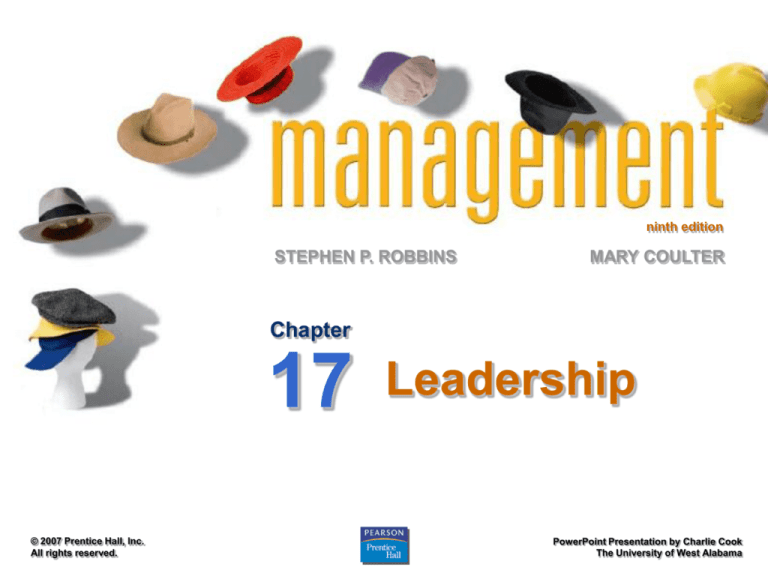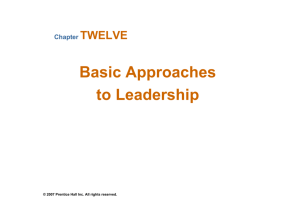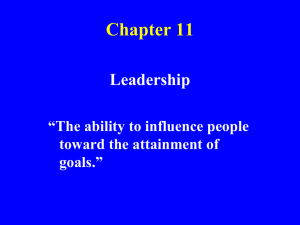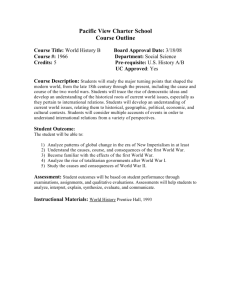
ninth edition
STEPHEN P. ROBBINS
MARY COULTER
Chapter
17
© 2007 Prentice Hall, Inc.
All rights reserved.
Leadership
PowerPoint Presentation by Charlie Cook
The University of West Alabama
LEARNING OUTLINE
• Who are Leaders and What is Leadership?
• Early Leadership Theories
• Contingency Theories of Leadership
• Contemporary Views on Leadership
• Leadership Issues in the Twenty First Century
Why is Leadership so important?
What makes leaders different from non-leaders?
What is the most appropriate style of leadership?
What can you do if you want to be seen as a leader?
© 2007 Prentice Hall, Inc. All rights reserved.
17–2
WHO ARE LEADERS AND WHAT IS
LEADERSHIP?
• Leader – Someone who can influence others and
who has managerial authority
• Leadership – What leaders do; the process of
influencing a group to achieve goals
• Ideally, all managers should be leaders
Leadership research has tried to answer: What is an
effective leader?
© 2007 Prentice Hall, Inc. All rights reserved.
17–3
Managers Versus Leaders
Managers
Leaders
[Root: “Handling things”]
[Root: “Taking people places”]
Are appointed to their
position.
Are appointed or emerge
from within a work group.
Can influence people only
to the extent of the formal
authority of their position.
Can influence other people
and have managerial
authority.
Do not necessarily have
the skills and capabilities
to be leaders.
Do not necessarily have the
skills and capabilities to be
managers.
Leadership is the process of influencing a
group toward the achievement of goals.
© 2007 Prentice Hall, Inc. All rights reserved.
17–4
EARLY LEADERSHIP THEORIES
• Trait Theories (1920s-30s)
Research focused on identifying personal
characteristics that differentiated leaders from nonleaders was unsuccessful.
Later research on the leadership process identified
seven traits associated with successful leadership:
Drive,
the desire to lead, honesty and integrity,
self-confidence, intelligence, job-relevant
knowledge, and extraversion.
© 2007 Prentice Hall, Inc. All rights reserved.
17–5
Behavioral Theories of Leadership
1.
2.
3.
4.
University of Iowa Studies (Kurt Lewin)
Ohio State Studies
University of Michigan Studies
The Managerial Grid
© 2007 Prentice Hall, Inc. All rights reserved.
17–6
• Behavioral Theories
University of Iowa Studies (Kurt Lewin)
Identified
three leadership styles:
– Autocratic style: centralized authority, low participation
– Democratic style: involvement, high participation,
feedback
– Laissez faire style: hands-off management
Research
findings: mixed results
– No specific style was consistently better for producing
better performance
– Employees were more satisfied under a democratic leader
than an autocratic leader.
© 2007 Prentice Hall, Inc. All rights reserved.
17–7
Early Leadership Theories (cont’d)
• Behavioral Theories (cont’d)
Ohio State Studies
Identified
two dimensions of leader behavior
– Initiating structure: the role of the leader in defining his
or her role and the roles of group members
– Consideration: the leader’s mutual trust and respect for
group members’ ideas and feelings.
Research
findings: mixed results
– High-high leaders generally, but not always, achieved high
group task performance and satisfaction.
– Evidence indicated that situational factors appeared to
strongly influence leadership effectiveness.
© 2007 Prentice Hall, Inc. All rights reserved.
17–8
Early Leadership Theories (cont’d)
• Behavioral Theories (cont’d)
University of Michigan Studies
Identified
two dimensions of leader behavior
– Employee oriented: emphasizing personal relationships
– Production oriented: emphasizing task accomplishment
Research
findings:
– Leaders who are employee oriented are strongly
associated with high group productivity and high job
satisfaction.
© 2007 Prentice Hall, Inc. All rights reserved.
17–9
Exhibit 17–3
The
Managerial
Grid
17–10
Exhibit 17–2
Behavioral Theories of Leadership
© 2007 Prentice Hall, Inc. All rights reserved.
17–11
Exhibit 17–2 (cont’d) Behavioral Theories of Leadership
© 2007 Prentice Hall, Inc. All rights reserved.
17–12
CONTINGENCY THEORES OF LEADERSHIP
• Being an effective leader requires not only an understanding of
traits and behaviors, but and understanding of the situation in
which the leader is attempting to lead, as well.
• There are four contingency theories ;
Fiedler Model
Hersey and Blanchard’s Situational Leadership Theory
Leader Participation Model
Path-Goal Model
Each of these theories looks at defining leadership style and the situation,
and attempts to answer the if-then contingencies (If this is the context of
the situation, then this is the best leadership style to use.)
Assumptions: underlying the different models:
Fiedler: Leader’s style is fixed
Other’s: Leader’s style can and should be changed
17–13
The Fiedler Model
• The Fiedler Contingency Model proposed that effective
group performance depended upon the proper match
between the leader’s style of interacting with his or her
followers and the degree to which the situation allowed
the leader to control and influence.
• The model is based on the premise that a certain
leadership style would be most effective in different
types of situations.
• Fiedler proposed that e key factor in leadership success
was an individual’s basic leadership style, either task
oriented or relationship oriented. To measure the
leaders' style, Fiedler developed Least Preferred Coworker (LPC) Questionnaire.
© 2007 Prentice Hall, Inc. All rights reserved.
17–14
• After an individual's leadership style had been assessed,
it was necessary to evaluate the situation in order to
match the leader with the situation.
• Fiedler defined three contingency dimensions for the key
situational factors for determining leader effectiveness.
These were;
Leader Member Relations: The degree of confidence, trust, and
respect employees had for their leader: Good, or Poor.
Task Structure: The degree to which job assignments were
formalized. High or Low.
Position Power: The degree of influence a leader had over
power based activities such as hiring, firing, dicipline,
promotions, and salary increases. Strong or Weak.
© 2007 Prentice Hall, Inc. All rights reserved.
17–15
Findings of the Fiedler Model
Good
Performance
Task-Oriented
Relationship
-Oriented
Poor
Favorable
• Category
• Leader-Member
Relations
• Task Structure
• Position Power
Unfavorable
Moderate
I
II
Good
III
Good
IV
Good
V
Poor
VI
Poor
VII
Poor
VIII
Poor
Good
High
Strong
High
Weak
Low
Strong
Low
Weak
High
Strong
High
Weak
Low
Strong
Low
Weak
Findings from Fiedler Model
E X H I B I T 12–2
© 2007 Prentice Hall Inc. All rights reserved.
Fiedler Model
• Leader: Style is Fixed (Task oriented vs. Relationship
oriented)
• Considers Situational Favorableness for Leader
Leader-member relations
Task structure
Position power
Key Assumption
– Leader must fit situation; options to accomplish
this:
– Select leader to fit situation
– Change situation to fit leader
Fiedler’s Model: The Leader
Assumption: Leader’s Style is Fixed & Can be
Measured by the Least Preferred Co-Worker
(LPC) Questionnaire
Least Preferred Co-Worker (LPC)
Questionnaire
The way in which a leader will
evaluate a co-worker that is not
liked will indicate whether the
leader is task- or relationshiporiented.
© 2007 Prentice Hall Inc. All rights reserved.
• Each leadership situation was evaluated in
terms of these three contingency variables in
which produced eight possible situations in
which a leader could find himself or herself.
• Situations I, II, III were classified as very
favorable for the leader,
• IV, V, VI were Moderately favorable for the
leader.
• VII and VIII were described as very unfavorable
for the leader.
© 2007 Prentice Hall, Inc. All rights reserved.
17–20
Contingency Theories… (cont’d)
• Hersey and Blanchard’s Situational Leadership
Theory (SLT)
Argues that successful leadership is achieved by
selecting the right leadership style which is contingent
on the level of the followers’ readiness.
Acceptance:
leadership effectiveness depends on
whether followers accept or reject a leader.
Readiness:
the extent to which followers have the
ability and willingness to accomplish a specific
task.
Leaders must relinquish control over and contact with
followers as they become more competent.
© 2007 Prentice Hall, Inc. All rights reserved.
17–21
Contingency Theories… (cont’d)
• Hersey and Blanchard’s Situational Leadership
Theory (SLT)
Creates four specific leadership styles incorporating
Fiedler’s two leadership dimensions:
Telling:
high task-low relationship leadership
Selling:
high task-high relationship leadership
Participating:
low task-high relationship
leadership
Delegating:
© 2007 Prentice Hall, Inc. All rights reserved.
low task-low relationship leadership
17–22
Contingency Theories… (cont’d)
• Hersey and Blanchard’s Situational Leadership
Theory (SLT)
Posits four stages of follower readiness:
R1:
followers are unable and unwilling
R2:
followers are unable but willing
R3:
followers are able but unwilling
R4:
followers are able and willing
© 2007 Prentice Hall, Inc. All rights reserved.
17–23
Hersey and Blanchard’s Situational Leadership Model
Source: Reprinted with permission from the Center for Leadership
Studies. Situational Leadership® is a registered trademark of the Center
for Leadership Studies. Escondido, California. All rights reserved.
Exhibit 17.5
© 2007 Prentice Hall, Inc. All rights reserved.
17–24
Leader-Participation Model
Premise:
•Rule based decision tree to guide leaders about
when and when not to include subordinate
participation in decision making
•Considers 12 contingency variables to consider
whether or not to include subordinates in decision
making
© 2007 Prentice Hall Inc. All rights reserved.
Contingency Variables in the Revised
Leader-Participation Model
1.
2.
3.
4.
5.
6.
7.
Importance of the decision
Importance of obtaining follower commitment to the decision
Whether the leader has sufficient information to make a good decision
How well structured the problem is
Whether an autocratic decision would receive follower commitment
Whether followers “buy into” the organization’s goals
Whether there is likely to be conflict among followers over solution
alternatives
8. Whether followers have the necessary information to make a good decision
9. Time constraints on the leader that may limit follower involvement
10. Whether costs to bring geographically dispersed members together is
justified
11. Importance to the leader of minimizing the time it takes to make the decision
12. Importance of using participation as a tool for developing follower decision
skills
E X H I B I T 12–5
© 2007 Prentice Hall Inc. All rights reserved.
Path-Goal Theory
Premise
• Leader must help followers
attaining goals and reduce
roadblocks to success
•Leaders must change behaviors to
fit the situation (environmental
contingencies & subordinate
contingencies)
© 2007 Prentice Hall Inc. All rights reserved.
The Path-Goal Theory
E X H I B I T 12–4
© 2007 Prentice Hall Inc. All rights reserved.
CONTEMPORARY VIEWS ON
LEADERSHIP
• Transactional Leadership
Leaders who guide or motivate their followers in the
direction of established goals by clarifying role and
task requirements.
• Transformational Leadership
Leaders who inspire followers to transcend their own
self-interests for the good of the organization by
clarifying role and task requirements.
Leaders who also are capable of having a profound
and extraordinary effect on their followers.
© 2007 Prentice Hall, Inc. All rights reserved.
17–29
Contemporary Views…(cont’d)
• Charismatic Leadership
An enthusiastic, self-confident leader whose
personality and actions influence people to behave in
certain ways.
Characteristics of charismatic leaders:
Have
a vision.
Are
able to articulate the vision.
Are
willing to take risks to achieve the vision.
Are
sensitive to the environment and follower
needs.
Exhibit
behaviors that are out of the ordinary.
© 2007 Prentice Hall, Inc. All rights reserved.
17–30
Contemporary Views…(cont’d)
• Visionary Leadership
A leader who creates and articulates a realistic,
credible, and attractive vision of the future that
improves upon the present situation.
• Visionary leaders have the ability to:
Explain the vision to others.
Express the vision not just verbally but through
behavior.
Extend or apply the vision to different leadership
contexts.
© 2007 Prentice Hall, Inc. All rights reserved.
17–31
Contemporary Views…(cont’d)
• Team Leadership Characteristics
Having patience to share information
Being able to trust others and to give up authority
Understanding when to intervene
• Team Leader’s Job
Managing the team’s external boundary
Facilitating the team process
Coaching,
facilitating, handling disciplinary
problems, reviewing team and individual
performance, training, and communication
© 2007 Prentice Hall, Inc. All rights reserved.
17–32
Leadership Issues in the 21st Century
• Managing Power
Legitimate power
The power a leader has
as a result of his or her
position.
Coercive power
The power a leader has
to punish or control.
Reward power
The power to give
positive benefits or
rewards.
© 2007 Prentice Hall, Inc. All rights reserved.
Expert power
The influence a leader
can exert as a result of
his or her expertise,
skills, or knowledge.
Referent power
The power of a leader
that arise because of a
person’s desirable
resources or admired
personal traits.
17–33
Empowering Employees
• Empowerment
Involves increasing the decision-making discretion of
workers such that teams can make key operating
decisions in develop budgets, scheduling workloads,
controlling inventories, and solving quality problems.
Why empower employees?
Quicker
responses problems and faster decisions.
Addresses
the problem of increased spans of
control in relieving managers to work on other
problems.
© 2007 Prentice Hall, Inc. All rights reserved.
17–34
Gender Differences and Leadership
• Research Findings
Males and females use different styles:
Women
tend to adopt a more democratic or
participative style unless in a male-dominated job.
Women
Men
tend to use transformational leadership.
tend to use transactional leadership.
© 2007 Prentice Hall, Inc. All rights reserved.
17–35
Exhibit 17–11 Where Female Managers Do Better: A Scorecard
Source: R. Sharpe, “As Leaders, Women Rule,” BusinessWeek, November 20. 2000, p. 75.
© 2007 Prentice Hall, Inc. All rights reserved.
17–36
Leadership Can Be Irrelevant!
• Substitutes for Leadership
Follower characteristics
Experience, training, professional orientation, or
the need for independence
Job characteristics
Routine, unambiguous, and satisfying jobs
Organization characteristics
Explicit formalized goals, rigid rules and
procedures, or cohesive work groups
© 2007 Prentice Hall, Inc. All rights reserved.
17–37
ninth edition
STEPHEN P. ROBBINS
MARY COULTER
THANK YOU FOR LISTENING
ANY QUESTIONS????
© 2007 Prentice Hall, Inc.
All rights reserved.
PowerPoint Presentation by Charlie Cook
The University of West Alabama







